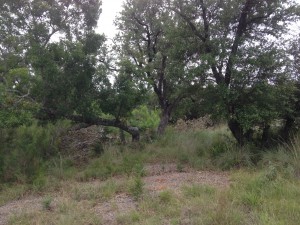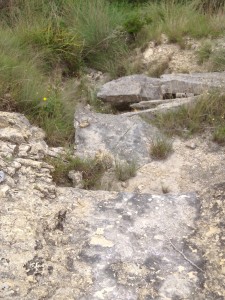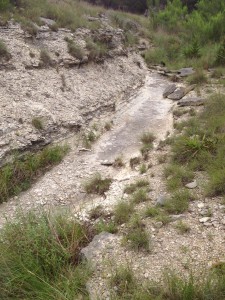The day is Sunday, June 22nd in peaceful Dripping Springs, Texas. The time is approximately 10:43am and partially cloudy. It’s a perfect morning to be outside, the temperature is 82 degrees farenheit with a slight breeze to cool things off. I went to the same location as my first initial blogpost to compare the difference to the same location over time.
As you can tell from the photos from the first blog compared to the photos in this blog post, things have greatly changed. The photo of the creek bed is completely dry now due to the Texas drought, when before there was actually some small amounts of water on the bottom. Also, the creek bed now is more dry obviously, but there’s actually silt or soft dirt deposit on the creek bed as opposed to the previous small water puddle.
I thought it was interesting to include the picture of the cactus in this blog post because of its ability to thrive without water, especially in the current drought. I didn’t notice the cactus the first time around unfortunately, but the cactus has clearly been unaffected.
Let’s examine another picture, the rock water fall this time around. This time you can tell in the picture the rocks are substantially dryer than before. Due to the drought the area gives off the hint of looking more worn. In the first blog post there was small amount of water on the rocks. This made the first original photo appear to have more moisture compared to the one now. As mentioned earlier in this blog post the drought left dust residue and silt on the rock formations.
This last picture is a personal favorite of mine, because it shows the effect of the storm last week on the land. There were reported wing gusts of up to 70 miles per hour in the hill country of Dripping Springs and it unfortunately blew over many trees in the area. I was just fortunate that a tree was blown over in the same area as my first blog post. It was interesting to note the rate of speed that a tree dies. I didn’t think the leafs would already be completely brown in a little over a weeks time. Upon closer examination I took into account that the tree’s actually root system was no longer attached to the ground, the wind had actually uprooted the entire tree instead of just blowing it over. I can only imagine the several species and small habitats this single knocked over tree affected, for instance, birds, birds nest, potential rabbit holes within the roots, and the insects that called the tree home.
The aftermath of the storm and several weeks of drought were extremely noticeable when comparing the first blog post to this current blog post. To think, that is just within a three week time period. I can’t even imagine what things would look like if these current weather conditions last an entire year or several years for that matter. Not only would the creek bed be dry as it currently is, but the surrounding vegetation would be completely depleted and dead as well.
Taylor Johnson




